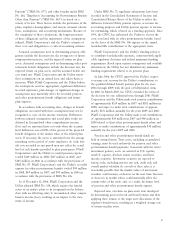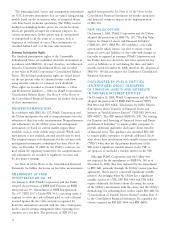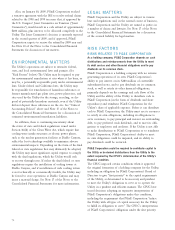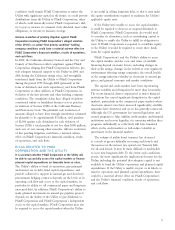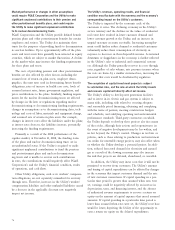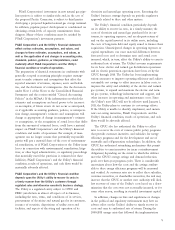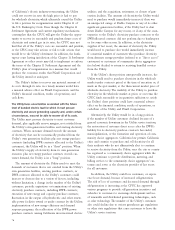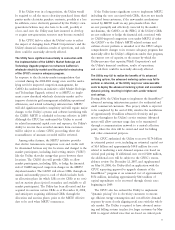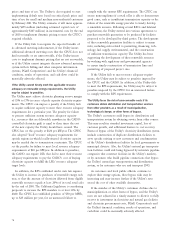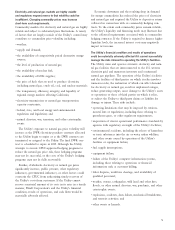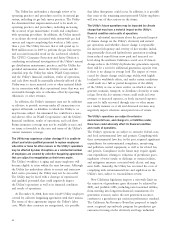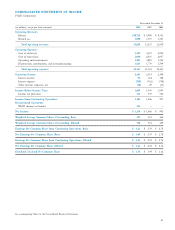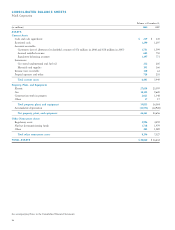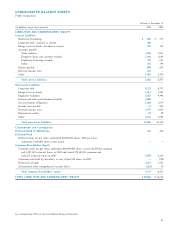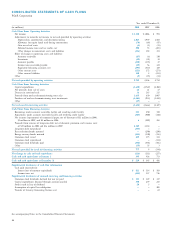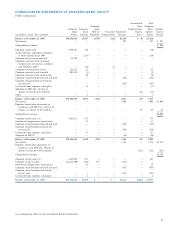PG&E 2008 Annual Report Download - page 79
Download and view the complete annual report
Please find page 79 of the 2008 PG&E annual report below. You can navigate through the pages in the report by either clicking on the pages listed below, or by using the keyword search tool below to find specific information within the annual report.77
If the Utility incurs signifi cant costs to implement MRTU,
including the costs associated with CRRs, that are not timely
recovered from customers; if the new market mechanisms
created by MRTU result in any price/market fl aws that
are not promptly and effectively corrected by the market
mechanisms, the CAISO, or the FERC; if the Utility’s CRRs
are not suffi cient to hedge the fi nancial risk associated with
its CAISO-imposed congestion costs under MRTU; if either
the CAISO’s or the Utility’s MRTU-related systems and
software do not perform as intended or if the CPUC adopts
comprehensive changes to its resource adequacy program that
materially affect the Utility’s obligations under that program,
the current cost of capacity, or the means by which the
Utility procures that capacity, PG&E Corporation’s and
the Utility’s fi nancial condition, results of operations,
and cash fl ows could be materially adversely affected.
The Utility may fail to realize the benefi ts of its advanced
metering system, the advanced metering system may fail to
perform as intended, or the Utility may incur unrecoverable
costs to deploy the advanced metering system and associated
dynamic pricing, resulting in higher costs and/or reduced
cost savings.
During 2006, the Utility began to implement the SmartMeter™
advanced metering infrastructure project for residential and
small commercial customers. This project, which is expected
to be completed by the end of 2011, involves the installation
of approximately 10 million advanced electricity and gas
meters throughout the Utility’s service territory. Advanced
meters will allow customer usage data to be transmitted
through a communication network to a central collection
point, where the data will be stored and used for billing
and other commercial purposes.
The CPUC authorized the Utility to recover $1.74 billion
in estimated project costs, including an estimated capital cost
of $1.4 billion and approximately $54.8 million for costs
related to marketing a new demand response rate based on
critical peak pricing. If additional costs exceed $100 million,
the additional costs will be subject to the CPUC’s reason-
ableness review. On December 12, 2007, and supplemented
on May 14, 2008, the Utility fi led an application with the
CPUC requesting approval to upgrade elements of the
SmartMeter™ program at an estimated cost of approximately
$572 million, including approximately $463 million of
capital expenditures to be recovered through electric rates
beginning in 2009.
The CPUC also has ordered the Utility to implement
“dynamic pricing” for its electricity customers to encour-
age effi cient energy consumption and cost-effective demand
response by more closely aligning retail rates with the whole-
sale market. The Utility is required to have advanced meter-
ing and billing systems in place for larger customers by May
2010 to support default rates that are based on critical peak
If the Utility were in a long position, the Utility would
be required to sell the excess electricity purchased from third
parties under electricity purchase contracts, possibly at a loss.
In addition, excess electricity generated by the Utility’s own
generation facilities may also have to be sold, possibly at
a loss, and costs the Utility may have incurred to develop
or acquire new generation resources may become stranded.
If the CPUC fails to adjust the Utility’s rates to refl ect
the impact of changing loads, PG&E Corporation’s and the
Utility’s fi nancial condition, results of operations, and cash
fl ows could be materially adversely affected.
The Utility faces signifi cant uncertainty in connection with
the implementation of the CAISO’s Market Redesign and
Technology Upgrade program to restructure California’s
wholesale electricity market and the potential restructuring
of the CPUC’s resource adequacy program.
In response to the electricity market manipulation that
occurred during the 2000-2001 energy crisis and the under-
lying need for improved congestion management, the
CAISO has undertaken an initiative called Market Redesign
and Technology Upgrade, referred to as MRTU, to imple-
ment a new day-ahead wholesale electricity market and to
improve electricity grid management reliability, operational
effi ciencies, and related technology infrastructure. MRTU
will add signifi cant market complexity and will require major
changes to the Utility’s systems and software interfacing with
the CAISO. MRTU is scheduled to become effective in 2009.
Although the CPUC has authorized the Utility to record
its related incremental capital costs and expenses, the Utility’s
ability to recover these recorded amounts from customers
will be subject to a future CPUC proceeding where the
reasonableness of amounts recorded will be reviewed.
Among other features, the MRTU initiative provides
that electric transmission congestion costs and credits will
be determined between any two locations and charged to the
market participants, including load serving entities (“LSEs”)
like the Utility, that take energy that passes between those
locations. The CAISO also will provide CRRs to allow
market participants, including LSEs, to hedge the fi nancial
risk of CAISO-imposed congestion charges in the MRTU
day-ahead market. The CAISO will release CRRs through an
annual and monthly process, each of which includes both
an allocation phase (in which LSEs receive CRRs at no cost)
and an auction phase (priced at market, and available to all
market participants). The Utility has been allocated and has
acquired via auction certain CRRs as of December 31, 2008,
and anticipates acquiring additional CRRs through the
allocation and auction phases prior to the MRTU effective
date to be used when MRTU commences.


